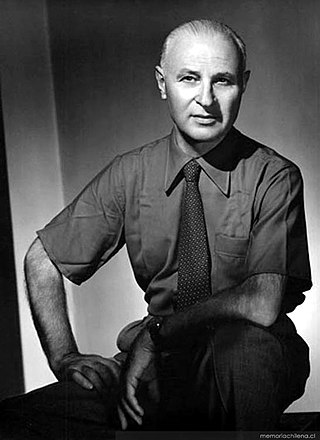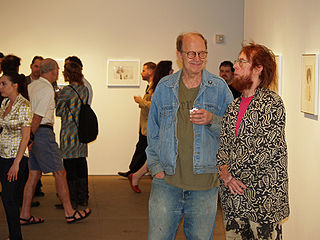
Joseph Wright, styled Joseph Wright of Derby, was an English landscape and portrait painter. He has been acclaimed as "the first professional painter to express the spirit of the Industrial Revolution".

Edward Ralph Kienholz was an American installation artist and assemblage sculptor whose work was highly critical of aspects of modern life. From 1972 onwards, he assembled much of his artwork in close collaboration with his artistic partner and fifth wife, Nancy Reddin Kienholz. Throughout much of their career, the work of the Kienholzes was more appreciated in Europe than in their native United States, though American museums have featured their art more prominently since the 1990s.

John Bellany was a Scottish painter.

Jim Gary was an American sculptor popularly known for his large, colorful creations of dinosaurs made from discarded automobile parts. These sculptures were typically finished with automobile paint although some were left to develop a natural patina during display outdoors.

Louise Lawler is a U.S. artist and photographer living in Brooklyn, New York. From the late 1970s onwards, Lawler’s work has focused on photographing portraits of other artists’ work, giving special attention to the spaces in which they are placed and methods used to make them. Examples of Lawler's photographs include images of paintings hanging on the walls of a museum, paintings on the walls of an art collector's opulent home, artwork in the process of being installed in a gallery, and sculptures in a gallery being viewed by spectators.

Emilio Pettoruti (1892–1971) was an Argentine painter, who caused a scandal with his avant-garde cubist exhibition in 1924 in Buenos Aires. At the beginning of the twentieth century, Buenos Aires was a city full of artistic development. Pettoruti's career was thriving during the 1920s when "Argentina witnessed a decade of dynamic artistic activity; it was an era of euphoria, a time when the definition of modernity was developed." While Pettoruti was influenced by Cubism, Futurism, Constructivism, and Abstraction, he did not claim to paint in any of those styles in particular. Exhibiting all over Europe and Argentina, Emilio Pettoruti is remembered as one of the most influential artists in Argentina in the 20th century for his unique style and vision.

An art dealer is a person or company that buys and sells works of art, or acts as the intermediary between the buyers and sellers of art.

The Institute of Contemporary Art (ICA) is an art museum and exhibition space located in Boston, Massachusetts, United States. The museum was founded as the Boston Museum of Modern Art in 1936. Since then it has gone through multiple name changes as well as moving its galleries and support spaces over 13 times. Its current home was built in 2006 in the South Boston Seaport District and designed by architects Diller Scofidio + Renfro.

The Huntington Museum of Art is a nationally accredited art museum located in the Park Hills neighborhood above Ritter Park in Huntington, West Virginia. Housed on over 50 acres of land and occupying almost 60,000 square feet, it is the largest art museum in the state of West Virginia. The museum's campus is home to nature trails and the C. Fred Edwards Conservatory, a subtropical and tropical plant conservatory. The museum's collection includes American and European paintings, sculptures, prints, and drawings, as well as glass pieces manufactured in West Virginia and the Ohio Valley, American folk art, Chinese and Japanese decorative objects, Haitian art, firearms, and decorative arts from the Near East. In addition to its permanent collections, the museum hosts traveling exhibitions and houses the James D. Francis Art Research Library, the Grace Rardin Doherty Auditorium, and five art studios where artists in residence are periodically hosted and classes are held. The Huntington Museum of Art holds one of the largest collections of art in the state of West Virginia.

A private collection is a privately owned collection of works or valuable items. In a museum or art gallery context, the term signifies that a certain work is not owned by that institution, but is on loan from an individual or organization, either for temporary exhibition or for the long term. This source is usually an art collector, although it could also be a school, church, bank, or some other company or organization. By contrast, collectors of books, even if they collect for aesthetic reasons, are called bibliophiles, and their collections are typically referred to as libraries.
Tino Sehgal is an artist of German and Indian descent, based in Berlin, who describes his work as "constructed situations". He is also thought of as a choreographer who makes dance for the museum setting.

A contemporary art gallery is normally a commercial art gallery operated by an art dealer which specializes in displaying for sale contemporary art, usually new works of art by living artists. This approach has been called the "Castelli Method" after Leo Castelli, whose success was attributed to his active involvement in discovering and promoting emerging artists beginning in the late 1950s with Jasper Johns and Robert Rauschenberg.

Jonathan Talbot, is an American collage artist, painter, and printmaker. He also is the creator of an innovative collage technique that eliminates liquid adhesives from the collage assembly process. His technique is the subject of his book, Collage: A New Approach.
Carmen Herrera was a Cuban-born American abstract, minimalist visual artist and painter. She was born in Havana and lived in New York City from the mid-1950s. Herrera's abstract works brought her international recognition late in life.
Daphne Wright is an Irish visual artist, who makes sculptural installations using a variety of techniques and media to explore how a range of languages and materials can be used to probe unspoken human preoccupations. Recent international exhibition highlights include Hotspot, Galleria Nazionale d’Arte Moderna e Contemporanea, Rome, curated by Gerardo Mosquera; Daphne Wright: Prayer Project, Davis Museum, USA, Portals; the Hellenic Parliament with ΝΕΟΝ, Athens; Infinite Sculpture, Gulbenkian Museum, Lisbon. Wright curated the 2018 exhibition The Ethics of Scrutiny at the Irish Museum of Modern Art as part of the Freud Project. Wright has received the Paul Hamlyn Award, The Henry Moore Foundation Fellowship, and The British School of Rome fellowship. She is a member of Aosdana and is represented by Frith Street Gallery, London.
Willie Young is a 20th-century American artist. Young is mainly self-taught, and his work has been exhibited alongside other prominent outsider artists, such as Bill Traylor, Nellie Mae Rowe and Thornton Dial. The main body of his work consists of delicately rendered graphite drawings.
Rachel Maclean is a Scottish multi-media artist. She lives and works in Glasgow. She has shown widely in the UK and internationally, in galleries, museums, film festivals and on television. Maclean produces elaborate films and digital prints using extravagant costume, over-the-top make-up, green screen vfx and electronic soundtracks.
Rosemary Elizabeth Allan (1911-2008) was a British painter.

An art gallery is a room or a building in which visual art is displayed. In Western cultures from the mid-15th century, a gallery was any long, narrow covered passage along a wall, first used in the sense of a place for art in the 1590s. The long gallery in Elizabethan and Jacobean houses served many purposes including the display of art. Historically, art is displayed as evidence of status and wealth, and for religious art as objects of ritual or the depiction of narratives. The first galleries were in the palaces of the aristocracy, or in churches. As art collections grew, buildings became dedicated to art, becoming the first art museums.
Susan Kaprov is an American multi-disciplinary artist whose work spans the fields of photography, painting, graphic design, and installation art.














